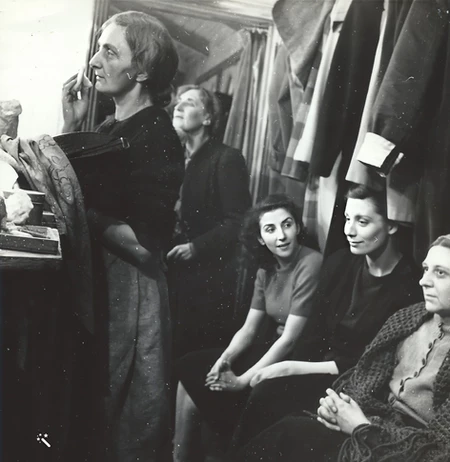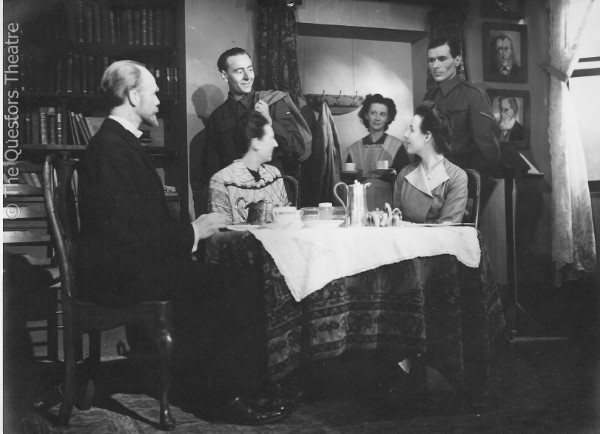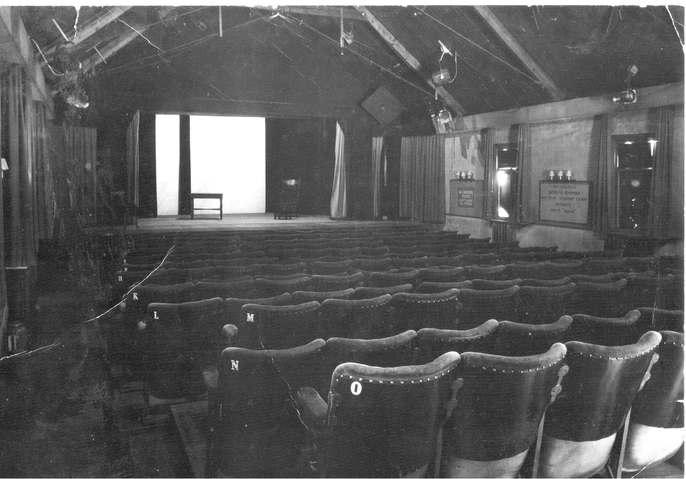
SEASON 19 (1947-48)
The Discovery
Mr Bolfry
Six Characters in Search of an Author
The Trojan Women
The Apple Cart
 A major event to affect the quality and scope of productions this season was the acquisition of the premises at the rear of the site formerly occupied by the Barn Club.
A major event to affect the quality and scope of productions this season was the acquisition of the premises at the rear of the site formerly occupied by the Barn Club.
This was a tremendous step forward because, up until this point, performances, rehearsals, auditions, construction of scenery, making of costumes, committee meetings and general office administration all had to be carried out in the theatre building itself.
Obviously the stage and auditorium took up most of the space and at the back of the auditorium there was only room for a tiny kitchen and a small office which doubled as the Box Office.
Behind the stage there was one long dressing room [see photo], little more than a corridor, divided into two compartments by a curtain. The new Annexe made room for a workshop, a paint store and a much needed rehearsal room on the ground level, with wardrobe accomodation and a small office-cum-library above.
September 1947
THE DISCOVERY
by Frances Sheridan
Directed by Alfred Emmet
Designed by Beryl Anthony
This was considered a fair success, although a fall in membership numbers led to the number of performances being reduced to seven.

The Director's report is interesting in that it reveals the difficulties with regard to the provision of scripts in the age before photocopying.
"...tribute should be paid to Rena Rice, Kit Hutchins and Mac Golding, who spent many hours at the B.D.L. [British Drama League] typing copies of the original script, which then had to be cut and amended and then typed again. The consequence of the delay was that I only had a copy just before I went away on holiday in the middle of July and could not start work on the cutting before I went away, and had to plunge into rehearsals soon after my return with inadequate time for thorough work on the production script before rehearsals began. This affected the quality of my work and resulted in a degree of uncertainty in the handling of certain scenes in the early rehearsal stages."
The press review didn't mince it's words!
"I did not like the choice of play - the sentiments of that period are too obsolete and I felt considerable impatience and boredom, and a friend who was with us got up half way through the play and walked out, saying he, couldn't stand any more. The only redeeming features were the admirable acting of Wilf Sharp.....etc" !!
November 1947
MR BOLFRY
by James Bridie
Directed by Phyllis Pitt
Designed by Norman Branson
Nothing on record worth mentioning about this production, except to note that this was Phyllis Pitt's only production at The Questors (and maybe to speculate idly if she was any relation to Ed Pitt, who was to become a key director of ours some 30 years later - though I think it improbable).

This was Norman Branson's second set design for The Questors (his first being last season's CHILDREN IN UNIFORM). He was to become one of our regular designers in the Tin Hut and in just a few years time was to begin work on his crowning achievement, the design of our new Playhouse...but that is altogether another story.
February 1948
SIX CHARACTERS IN SEARCH OF AN AUTHOR
by Luigi Pirandello
Directed by Alfred Emmet
Designed by Beryl Anthony
The flier advertising this production admitted that we had neglected this influential Italian playwright up until this point. The production was a fitting and well received exploration of his most celebrated play. It drew wide attention and was another feather in The Questors' theatrical cap.

Alfred Emmet noted afterwards:
"Six Characters finished its successful run of nine performances and was followed by quite a lively discussion. George Devine [of the Old Vic] came to give us a very interesting and useful crit on the last night. The general impression seems to have been that it was one of the most interesting productions we have given for some time and of good standard."
April 1948
THE TROJAN WOMEN
by Euripides, translated by Gilbert Murray
Directed by Barbara (Kit) Hutchins.
This production, which used a large apron requiring some re-arrangement of the seating, marked a significant step forward in the exploration of stage format and triggered discussion on what shape the "playhouse of tomorrow"should take (see article in the programme).

Alfred Emmet:
"The Trojan Women I think surprised many people by coming near to a popular success and I certainly think most will agree that it was the most interesting and enterprisining production for a very long time.
John Burrell [our President at the time, and co-director ot the Old Vic] came to one of the performances to give us a criticism which was as penetrating and valuable as ever.
The show opened to rather thin houses but built up quite well towards the end of the run.
There was a rather exceptionally interesting discussion, much of which of course centred round the use of the exaggerated apron stage. There seems no doubt but that we must continue with our experiment in this direction."
The extended apron can just about be made out in the production photo above, and below is a reminder of the scale and capacity of the Tin Hut stage and auditorium - though dating from a few years later, 1956.
This was considered a fair success, although a fall in membership numbers led to the number of performances being reduced to seven.

May 1948
THE APPLE CART
By George Bernard Shaw
Directed by Alfred Emmet
Designed by Beryl Anthony
This was another substantial hit, smashing all previous Box Office records.

At one point enquiries were made to see if Peter Zadek of the Old Vic School, which George Devine had just opened, would be available to direct The Apple Cart. Clearly he was not, but our connections with the Old Vic School continued and George Devine was to become a member of the 'New Theatre Advisory Panel of eminent professionals' set up to advise us on our emerging plans to build our own theatre.
 Alfred Emmet (seen opposite in rehearsal for THE APPLE CART) remarked that despite this being regarded as a successful and popular show with a well attended after show discussion, "as so often happens with a show which has been generally liked, people did not seem to have very much to say."
Alfred Emmet (seen opposite in rehearsal for THE APPLE CART) remarked that despite this being regarded as a successful and popular show with a well attended after show discussion, "as so often happens with a show which has been generally liked, people did not seem to have very much to say."
The after show discussion was attended by the journalist Harold Downs, who wrote about it in his article "The Problem of Choosing Plays" in The Playgoer magazine. In it he refers to the rather mysterious method adopted for counting members' votes on the favourite show of the season, and their suggested plays for future consideration.

 A major event to affect the quality and scope of productions this season was the acquisition of the premises at the rear of the site formerly occupied by the Barn Club.
A major event to affect the quality and scope of productions this season was the acquisition of the premises at the rear of the site formerly occupied by the Barn Club. 





 Alfred Emmet (seen opposite in rehearsal for THE APPLE CART) remarked that despite this being regarded as a successful and popular show with a well attended after show discussion, "as so often happens with a show which has been generally liked, people did not seem to have very much to say."
Alfred Emmet (seen opposite in rehearsal for THE APPLE CART) remarked that despite this being regarded as a successful and popular show with a well attended after show discussion, "as so often happens with a show which has been generally liked, people did not seem to have very much to say."